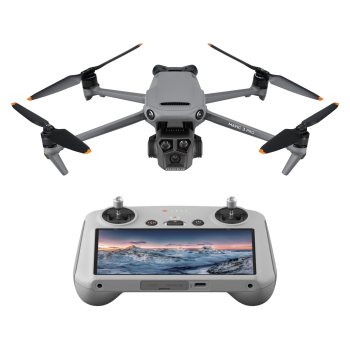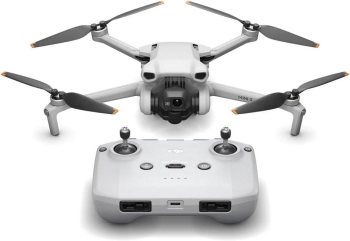- Exceptional image quality
- Long flight time
- Advanced safety features
- Easy to use
- Portable and lightweight
- Affordable entry-level option
- High price point
- Complex for beginners
- Limited camera features
- No obstacle avoidance
DJI Mavic 3 Pro vs DJI Mini 3
The world of DJI drones has evolved significantly over the years, with each new model offering improved features, enhanced performance, and increased versatility. Two of the most popular models currently available are the DJI Mavic 3 Pro and the DJI Mini 3. While both drones share some similarities, they also have distinct differences that set them apart from one another.
Design and Build
The DJI Mavic 3 Pro is a larger and more robust drone, weighing in at approximately 895 grams. Its body is made of high-quality magnesium alloy, which provides exceptional strength and durability. The drone's design is also more aerodynamic, with a sleek and curved shape that allows for smoother airflow and reduced wind resistance.
In contrast, the DJI Mini 3 is significantly smaller and lighter, weighing only around 249 grams. Its body is made of a combination of plastic and metal materials, which helps to keep its weight down while still maintaining a sturdy build. The Mini 3's design is more compact and foldable, making it easier to carry and transport.
Camera Capabilities
One of the most significant differences between the two drones is their camera capabilities. The DJI Mavic 3 Pro features a high-quality Hasselblad camera with a 4/3-inch CMOS sensor, which provides exceptional image quality and dynamic range. The camera is capable of capturing 20-megapixel still images and 5.1K video at 50fps.
The DJI Mini 3, on the other hand, features a 1/1.3-inch CMOS sensor, which is smaller than the Mavic 3 Pro's sensor. However, it still offers impressive camera capabilities, including 48-megapixel still images and 4K video at 60fps.
Flight Performance
Both drones offer exceptional flight performance, but the DJI Mavic 3 Pro has a slight edge when it comes to speed and agility. It has a top speed of up to 47mph (75kph) and can fly for up to 46 minutes on a single charge. The drone also features advanced obstacle avoidance systems, including five-directional sensing and omnidirectional obstacle sensing.
The DJI Mini 3, while not as fast as the Mavic 3 Pro, still offers impressive flight performance. It has a top speed of up to 36mph (58kph) and can fly for up to 51 minutes on a single charge. The drone also features advanced obstacle avoidance systems, including forward, backward, and downward sensing.
Features and Accessories
Both drones come with a range of features and accessories, including remote controllers, batteries, and charging cables. However, the DJI Mavic 3 Pro offers more advanced features, such as active tracking, gesture recognition, and a built-in display on the remote controller.
The DJI Mini 3, on the other hand, is more geared towards beginners and casual users. It still offers a range of features, including quick shots, panoramic shooting, and a built-in Level 5 wind resistance system.
Price
Finally, there's the issue of price. The DJI Mavic 3 Pro is significantly more expensive than the DJI Mini 3, with a starting price of around $2,199. The DJI Mini 3, on the other hand, starts at around $999.
In conclusion, both the DJI Mavic 3 Pro and the DJI Mini 3 are exceptional DJI drones that offer unique features and capabilities. While the Mavic 3 Pro is more geared towards professional users who require advanced camera capabilities and flight performance, the Mini 3 is perfect for beginners and casual users who want a compact and affordable drone. Ultimately, the choice between these two models will depend on your specific needs and preferences.

































